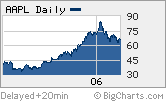|
Some soft spots for Apple stock
New products bring short-term risks, which have spooked some investors. Do they plant a seed for future gains?
NEW YORK (CNNMoney.com) - Investors in Apple got a late Christmas present when the company's shares soared well past the $80 mark in January. But since then, Apple's (down $0.31 to $65.92, Research) shares have dropped 23 percent from their January high of nearly $86 during the week of the company's annual Macworld event. That's when Apple unveiled its first Macs to contain Intel chips, several months ahead of schedule.
Also that week, Jobs pre-announced better-than-expected revenue for the December quarter and revealed that Apple had sold 14 million iPods, several million more than Wall Street analysts had expected and a three-fold increase over the previous year. So why have the shares dropped? Analysts and investors say part of it is simply profit taking, with some investors using the January highs as a chance to cash in. The January announcements helped the stock hit a record high. But they also blame the share price decline on the fact that Apple is in the midst of a "transitional quarter," selling its first Intel-based Macs and in the process of shifting its entire Mac line to include Intel chips. Such a big transition to the company's entire Mac line carries some risks, according to Erick Maronak, chief investment officer of Victory Capital Management's Victory NewBridge portfolio, which has shares of Apple. Maronak said the news about the Intel move created positive expectations for investors but also highlighted potential transition risks that, coupled with a normal seasonal slowdown for product sales after the holidays, contributed to the sell-off. "There are lots of balls in the air, and the expectation is things might slow," he said. Waiting for laptops
Steve Lidberg, an analyst with Pacific Crest Securities, pointed out that Apple has yet to release Intel-based versions of big sellers such as its iBook laptops, meaning potential buyers may still be sitting on the sidelines. "The progression is going well, but they're only selling a portion of their product lineup," said Analysts and investors point out that despite strong reviews for the company's new MacBook Pro laptops, the machines didn't begin shipping until late February, meaning Apple may not see a meaningful impact from sales of the new computer in the March quarter. And many potential buyers may also be sitting on the fence until improved software offerings for the Intel-based MacBook Pro laptops and the iMac desktops become available, according to Romeo Dator, co-manager of the All-American Equity Fund from U.S. Global Investors, whose fund owned shares of Apple as of the most recent quarter. Dator said Apple took software developers by surprise when it unveiled the Intel-based laptops ahead of schedule. This means shoppers will have to wait for software from non-Apple vendors such as Adobe and Microsoft that's created to run on Intel-based Macs. This is important because, despite the boost in processor speed thanks to the new "dual core" chips that essentially have two brains, software written for the old systems may actually perform slower on the new Macs than it did on the old ones. Dator said that anecdotally, he is aware of several people who want to buy MacBook Pro laptops but are waiting for the new software to come out, and he expects many others may be having the same thought. "Apple came out with another layer of software that reinterprets the older software so that it can run on this new design; that's why (performance) seems slower," Dator said. "Once they optimize software for dual-core chips, it should run faster than it ever has." But Michael Gartenberg, vice president & research director at Jupiter Research, thinks this mostly affects users of professional programs such as Adobe's Photoshop graphic design software. Slow season
Another factor that may have contributed to the decline in share price is the fact that March is traditionally a seasonally slower quarter for iPod and Mac sales. The shares experienced a further sell-off Wednesday when analyst Gene Munster of Piper Jaffray released a research note estimating that Apple will sell roughly nine million iPods in the current quarter, shy of many Wall Street analysts' expectations of 9.5 million. Muster thinks the pullback creates a buying opportunity for the shares, believing iPod demand will ramp up in the second half of the year. (Munster maintains an "outperform" rating on the stock; he does not own shares of Apple and his firm doesn't do banking business with the company.) While analysts and investors say they aren't concerned about Apple's long-term prospects, the near term is unclear. Analysts from Goldman Sachs say that it is too early to buy into Apple, but they think the near-term risks associated with the Intel transition will start to reverse themselves over the next year. That, coupled with the potential for new product announcements in the second half of the year, will heat up the stock again. "I think we're in a transition period; it's not necessarily just one quarter," said Pacific Crest's Lidberg. "The thing we remain focused on is what does the company have coming out of the product development pipeline that can continue to generate the momentum in the customer base that has been built on the iPod platform." ----------------------------- Apple's iTunes sells first movie: Click here. Fortune reviews the MacBook Pro: More here.
Jupiter's Gartenberg does not own shares of Apple, and his firm does not do investment banking. Pacific Crest's Lidberg does not own shares of Apple, and his firm does not do banking business with the company. |
|

